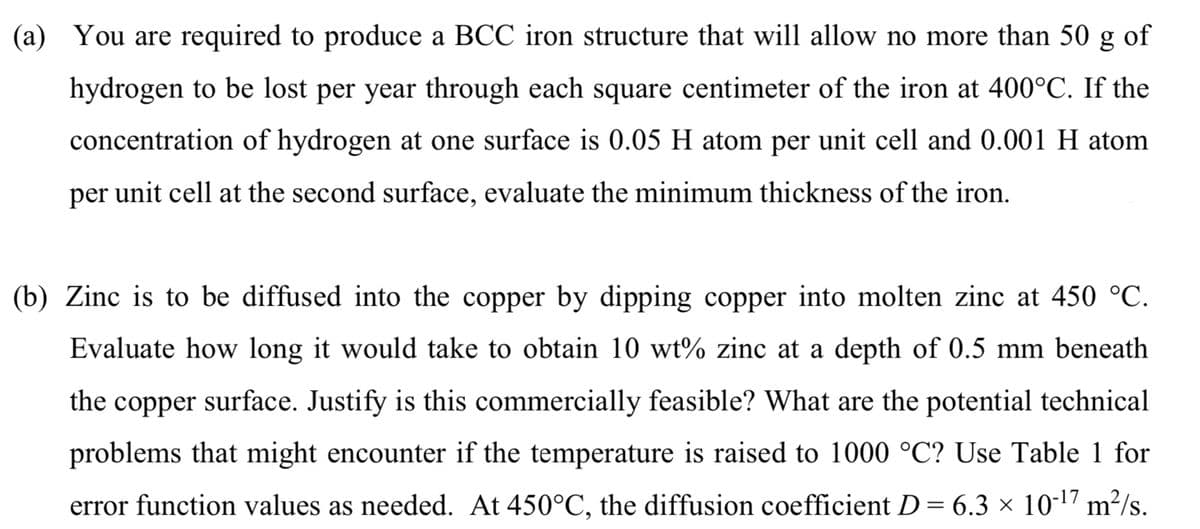(a) You are required to produce a BCC iron structure that will allow no more than 50 g of hydrogen to be lost per year through each square centimeter of the iron at 400°C. If the concentration of hydrogen at one surface is 0.05 H atom per unit cell and 0.001 H atom per unit cell at the second surface, evaluate the minimum thickness of the iron. (b) Zinc is to be diffused into the copper by dipping copper into molten zinc at 450 °C. Evaluate how long it would take to obtain 10 wt% zinc at a depth of 0.5 mm beneath the сорper surface. Justify is this commercially feasible? What are the potential technical problems that might encounter if the temperature is raised to 1000 °C? Use Table 1 for error function values as needed. At 450°C, the diffusion coefficient D= 6.3 × 1017 m²/s.
(a) You are required to produce a BCC iron structure that will allow no more than 50 g of hydrogen to be lost per year through each square centimeter of the iron at 400°C. If the concentration of hydrogen at one surface is 0.05 H atom per unit cell and 0.001 H atom per unit cell at the second surface, evaluate the minimum thickness of the iron. (b) Zinc is to be diffused into the copper by dipping copper into molten zinc at 450 °C. Evaluate how long it would take to obtain 10 wt% zinc at a depth of 0.5 mm beneath the сорper surface. Justify is this commercially feasible? What are the potential technical problems that might encounter if the temperature is raised to 1000 °C? Use Table 1 for error function values as needed. At 450°C, the diffusion coefficient D= 6.3 × 1017 m²/s.
Principles of Modern Chemistry
8th Edition
ISBN:9781305079113
Author:David W. Oxtoby, H. Pat Gillis, Laurie J. Butler
Publisher:David W. Oxtoby, H. Pat Gillis, Laurie J. Butler
Chapter22: Inorganic Materials
Section: Chapter Questions
Problem 52AP
Related questions
Question

Transcribed Image Text:(a) You are required to produce a BCC iron structure that will allow no more than 50 g of
hydrogen to be lost per year through each square centimeter of the iron at 400°C. If the
concentration of hydrogen at one surface is 0.05 H atom per unit cell and 0.001 H atom
per unit cell at the second surface, evaluate the minimum thickness of the iron.
(b) Zinc is to be diffused into the copper by dipping copper into molten zinc at 450 °C.
Evaluate how long it would take to obtain 10 wt% zinc at a depth of 0.5 mm beneath
the copper surface. Justify is this commercially feasible? What are the potential technical
problems that might encounter if the temperature is raised to 1000 °C? Use Table 1 for
error function values as needed. At 450°C, the diffusion coefficient D= 6.3 × 10-17 m²/s.
Expert Solution
This question has been solved!
Explore an expertly crafted, step-by-step solution for a thorough understanding of key concepts.
Step by step
Solved in 4 steps with 3 images

Knowledge Booster
Learn more about
Need a deep-dive on the concept behind this application? Look no further. Learn more about this topic, chemistry and related others by exploring similar questions and additional content below.Recommended textbooks for you

Principles of Modern Chemistry
Chemistry
ISBN:
9781305079113
Author:
David W. Oxtoby, H. Pat Gillis, Laurie J. Butler
Publisher:
Cengage Learning

Chemistry: The Molecular Science
Chemistry
ISBN:
9781285199047
Author:
John W. Moore, Conrad L. Stanitski
Publisher:
Cengage Learning

Physical Chemistry
Chemistry
ISBN:
9781133958437
Author:
Ball, David W. (david Warren), BAER, Tomas
Publisher:
Wadsworth Cengage Learning,

Principles of Modern Chemistry
Chemistry
ISBN:
9781305079113
Author:
David W. Oxtoby, H. Pat Gillis, Laurie J. Butler
Publisher:
Cengage Learning

Chemistry: The Molecular Science
Chemistry
ISBN:
9781285199047
Author:
John W. Moore, Conrad L. Stanitski
Publisher:
Cengage Learning

Physical Chemistry
Chemistry
ISBN:
9781133958437
Author:
Ball, David W. (david Warren), BAER, Tomas
Publisher:
Wadsworth Cengage Learning,

Chemistry & Chemical Reactivity
Chemistry
ISBN:
9781133949640
Author:
John C. Kotz, Paul M. Treichel, John Townsend, David Treichel
Publisher:
Cengage Learning

Chemistry & Chemical Reactivity
Chemistry
ISBN:
9781337399074
Author:
John C. Kotz, Paul M. Treichel, John Townsend, David Treichel
Publisher:
Cengage Learning